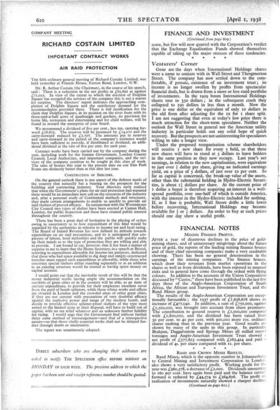Venturers' Corner
Gone are the days when International Holdings shares were a name to conjure with in Wall Street and Throgmorton Street. The company has now settled down to the com- fortable, if prosaic, existence of an investment trust; its income is no longer swollen by profits from spectacular financial deals, but is drawn from a more or less staid portfolio of investments. In the 1929 boom International Holdings shares rose to 35o dollars ; in the subsequent crash they collapsed to 190 dollars in less than a month. Now the price is one dollar or the equivalent of only to dollars in the old form after adjusting for the ro for 1 share split. I am not suggesting that even at today's low price there is much attraction for the short-term speculator. Neither the outlook for Wall Street in general nor the American utility industry in particular holds out any solid hope of quick recovery. But the prospects are not uninteresting for speculators willing to take a longer view. Under the proposed reorganisation scheme shareholders will receive I new share for every 5 held, so that these new shares will have to stand at 5 dollars to leave holders in the same position as they now occupy. Last year's net earnings, in relation to the new capitalisation, were equivalent to just over f dollar per share, giving an indicated earnings yield, on a price of 5 dollars, of just over ro per cent. So far as capital is concerned, the break-up value of the assets, other than the substantial holding in Hydro-Electric Securi- ties, is about If dollars per share. At the current price of dollar a buyer is therefore acquiring an interest in a well- spread portfolio, over one-half of which is outside America, with the interest in the Hydro-Electric included for nothing If, as I fear is probable, Wall Street drifts a little lower before recovering, International Holdings may become available for or dollars. An order to buy at such prices should one day show a useful profit.














































 Previous page
Previous page